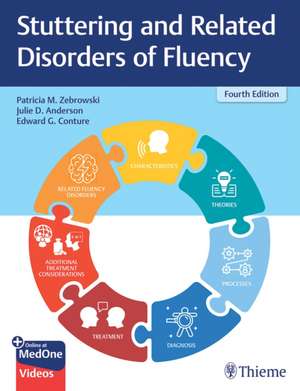Stuttering and Related Disorders of Fluency
Autor Patricia Zebrowski, Julie Anderson, Edward Contureen Limba Engleză Hardback – 7 iun 2022
Stuttering and Related Disorders of Fluency, Fourth Edition honors the philosophy that discoveries of the past are the bedrock of the present and the inspiration for future explorations-in this context-the nature and treatment of stuttering. Initially developed over 30 years ago, the first two editions were edited by the late Richard F. Curlee and the third edition was co-edited by Richard F. Curlee and Edward G. Conture. The latest edition, co-edited by Patricia M. Zebrowski, Julie D. Anderson, and Edward G. Conture, brings together contemporary insights and a multinational perspective from 44 world-class academicians, clinicians, and researchers in the field of stuttering and related disorders.
The book is organized into six sections and 17 chapters, with the first section describing basic facts and theories. The second section covers genetic, neural, linguistic, cognitive, and physiological factors. The third section features three dedicated chapters on the diagnosis of preschool-age children, school-age children, and adolescents and adults. The fourth section discusses treatment guidelines with three chapters organized by the same age demographics, while the fifth section covers language and phonological, bilingual and multicultural, and pharmacological considerations for treatment. The sixth, and last, section provides guidance on cluttering and acquired stuttering-from causes and symptoms to diagnosis and treatment.
Key Highlights
Up-to-date, reader-friendly text is ideal for students with no or limited background or experience in the nature and treatment of stuttering and related fluency disorders
Comprehensive content covering all relevant aspects of stuttering in diverse populations across the lifespan, including etiology, development, diagnosis, and treatment
Contributions from a diverse group of top scholars and practitioners from the United States, Canada, Western Europe, and Australia
This text is essential reading for upper-class undergraduates and early-stage graduate students in communication sciences and disorders. It also provides an invaluable classroom tool for instructors teaching basic courses on this subject and is a helpful sourcebook for researchers investigating stuttering and related fluency disorders.
This print book includes complimentary access to a digital copy on https://medone.thieme.com.
Preț: 547.65 lei
Preț vechi: 711.23 lei
-23% Nou
Puncte Express: 821
Preț estimativ în valută:
104.79€ • 109.69$ • 87.22£
104.79€ • 109.69$ • 87.22£
Carte disponibilă
Livrare economică 10-24 martie
Livrare express 21-27 februarie pentru 57.76 lei
Preluare comenzi: 021 569.72.76
Specificații
ISBN-13: 9781684202539
ISBN-10: 1684202531
Pagini: 312
Ilustrații: Beilage: Video
Dimensiuni: 222 x 279 x 23 mm
Greutate: 1.29 kg
Ediția:4. Auflage
Editura: MM – Thieme
ISBN-10: 1684202531
Pagini: 312
Ilustrații: Beilage: Video
Dimensiuni: 222 x 279 x 23 mm
Greutate: 1.29 kg
Ediția:4. Auflage
Editura: MM – Thieme
Cuprins
Section I: Some Characteristics and Theories
1 Common Characteristics
2 Some 20th- and 21st-Century Theories of Stuttering: A Brief Overview
Section II: Processes Associated with Stuttering
3 Genetic Processes
4 Speech, Language, and Cognitive Processes
5 Neural and Physiological Processes
6 Temperamental and Emotional Processes
Section III: Diagnosis of Stuttering
7 Preschool-Age Children
8 School-Age Children
9 Adolescents and Adults
Section IV: Treatment of Stuttering
10 Preschool-Age Children
11 School-Age Children
12 Adolescents and Adults
Section V: Additional Treatment Considerations
13 Language and Phonological Considerations
14 Bilingual and Multicultural Considerations
15 Pharmacological Considerations
Section VI: Related Fluency Disorders
16 Cluttering: Etiology, Symptomatology, Identification, and Treatment
17 Acquired Stuttering: Etiology, Symptomatology, Identification, and Treatment
1 Common Characteristics
2 Some 20th- and 21st-Century Theories of Stuttering: A Brief Overview
Section II: Processes Associated with Stuttering
3 Genetic Processes
4 Speech, Language, and Cognitive Processes
5 Neural and Physiological Processes
6 Temperamental and Emotional Processes
Section III: Diagnosis of Stuttering
7 Preschool-Age Children
8 School-Age Children
9 Adolescents and Adults
Section IV: Treatment of Stuttering
10 Preschool-Age Children
11 School-Age Children
12 Adolescents and Adults
Section V: Additional Treatment Considerations
13 Language and Phonological Considerations
14 Bilingual and Multicultural Considerations
15 Pharmacological Considerations
Section VI: Related Fluency Disorders
16 Cluttering: Etiology, Symptomatology, Identification, and Treatment
17 Acquired Stuttering: Etiology, Symptomatology, Identification, and Treatment
